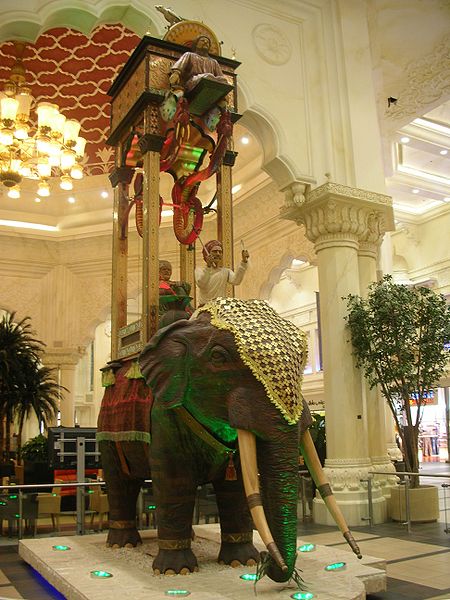The Elephant Clock: One of the greatest inventions of the outstanding mechanical engineer Al-Jazari
Page 1 of 1
 The Elephant Clock: One of the greatest inventions of the outstanding mechanical engineer Al-Jazari
The Elephant Clock: One of the greatest inventions of the outstanding mechanical engineer Al-Jazari
Al-Jazari was the most outstanding Islamic scholar, artisan, mechanical engineer, and inventor and is best known for his book The Book of Knowledge of Ingenious Mechanical Devices, which he wrote in 1206.
He was very much a practical engineer, and in the book he describes devices that he has built himself. In his day, the book was very popular, and many manuscript copies were made. He made a lot of improvements to the work of his predecessors and also made original innovations.
One of his best-known innovations is the 22 feet high Elephant clock. The horological technology used in it was drawn from earlier Indian clocks which were inspired by the technology of the Han Chinese clock, originally invented by the polymath Su Song. It consists of a weight powered water clock in the form of an elephant. The elements of the device are in the top part of the elephant and every half hour or an hour they move and make a sound.
The timing mechanism is hidden inside the elephant and is based on a water-filled basin. In the basin, there is a bucket, and inside the bucket, there is a deep bowl which floats in the water with a small hole in its center. After half an hour, the bowl is full of water entering through the center hole, and it pulls a string attached to the top tower on the elephant.
Then, the see-saw mechanism releases a ball that falls into a serpent’s mouth and from the weight he leans forward and pulls the bowl out of the water. When this action starts, the other figures in the top tower start to move. There is a figure that, at the same time as the serpent leans forward, raises one of his hands, while the driver of the elephant is hitting a drum.
After the action, the serpent returns to his original position. This cycle, which sometimes indicated half an hour, sometimes one hour, depending on the bowl used, repeats. It is very important that in the upper reservoir there are enough balls that can power the emptying of the bowl.
Reproductions of the elephant clock can be seen in a shopping mall in Dubai, the Ibn Battuta Mall, and the Musee d’Horlogerie du Locle in Switzerland. The whole construction represents different cultures: the elephant is from India, the serpents are from China, and the turban is from Islamic culture.

https://www.thevintagenews.com/2017/05/06/the-elephant-clock-one-of-the-greatest-inventions-of-the-outstanding-mechanical-engineer-al-jazari/
He was very much a practical engineer, and in the book he describes devices that he has built himself. In his day, the book was very popular, and many manuscript copies were made. He made a lot of improvements to the work of his predecessors and also made original innovations.
One of his best-known innovations is the 22 feet high Elephant clock. The horological technology used in it was drawn from earlier Indian clocks which were inspired by the technology of the Han Chinese clock, originally invented by the polymath Su Song. It consists of a weight powered water clock in the form of an elephant. The elements of the device are in the top part of the elephant and every half hour or an hour they move and make a sound.
The timing mechanism is hidden inside the elephant and is based on a water-filled basin. In the basin, there is a bucket, and inside the bucket, there is a deep bowl which floats in the water with a small hole in its center. After half an hour, the bowl is full of water entering through the center hole, and it pulls a string attached to the top tower on the elephant.
Then, the see-saw mechanism releases a ball that falls into a serpent’s mouth and from the weight he leans forward and pulls the bowl out of the water. When this action starts, the other figures in the top tower start to move. There is a figure that, at the same time as the serpent leans forward, raises one of his hands, while the driver of the elephant is hitting a drum.
After the action, the serpent returns to his original position. This cycle, which sometimes indicated half an hour, sometimes one hour, depending on the bowl used, repeats. It is very important that in the upper reservoir there are enough balls that can power the emptying of the bowl.
Reproductions of the elephant clock can be seen in a shopping mall in Dubai, the Ibn Battuta Mall, and the Musee d’Horlogerie du Locle in Switzerland. The whole construction represents different cultures: the elephant is from India, the serpents are from China, and the turban is from Islamic culture.

https://www.thevintagenews.com/2017/05/06/the-elephant-clock-one-of-the-greatest-inventions-of-the-outstanding-mechanical-engineer-al-jazari/
Guest- Guest
 Similar topics
Similar topics» Ticking clock can influence a woman's biological clock
» Two mega science inventions
» Controversial inventions by Indians
» Narendra Modi the greatest man since Gandhi? I accept that. Modi the saviour of the Indian nation? Accepted. Modi the sexiest man since Dharmendra? Accepted. Modi the greatest economist since Milton Friedman? Accepted.
» The 2012 TAZ Award for Outstanding Parsimony
» Two mega science inventions
» Controversial inventions by Indians
» Narendra Modi the greatest man since Gandhi? I accept that. Modi the saviour of the Indian nation? Accepted. Modi the sexiest man since Dharmendra? Accepted. Modi the greatest economist since Milton Friedman? Accepted.
» The 2012 TAZ Award for Outstanding Parsimony
Page 1 of 1
Permissions in this forum:
You cannot reply to topics in this forum